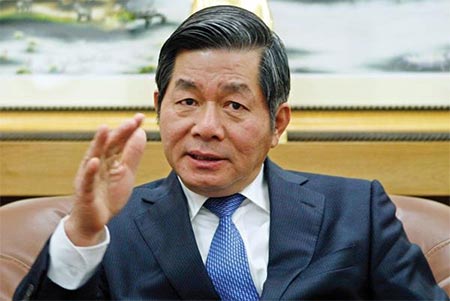Country needs new impetuses to bolster growth

Minister Bui Quang Vinh
Vinh stressed that if Vietnam failed to change the way it grew, it would be impossible to achieve 7-8 per cent annual growth in the future.
“We must find new impetuses for greater growth,” Vinh said. “The economy’s growth currently relies largely on capital, exports of raw natural resources and cheap labour. However, these propellants have waned.”
For example, he said, the state budget was “especially difficult”. “Despite low inflation, little money is available to insert into the economy. Development capital for this year would occupy 17 per cent of total expenditure, which is very low.”
The International Labour Organisation (ILO) recently reported that Vietnam’s labour productivity was among the lowest in the Asia-Pacific region. The country’s labour productivity was 15 times lower than in Singapore, and remained one-fifth that of Malaysia and two-fifths the level of Thailand. It was also 11 times and almost 10 times lower than in Japan and South Korea, respectively.
“A competitive economy can’t be built on low labour productivity. Many foreign investors don’t want to come to Vietnam due to this weakness,” said Nguyen Thi Nguyet Huong, a National Assembly member representing Hanoi.
However, according to Vinh, the macro-economic situation remained stable, with low inflation of under 5 per cent this year, and banks’ low lending rates of 6-7 per cent, per year. Also, the local currency and gold prices had become quite stable, with foreign currency reserves strongly increasing over the past months.
“The economy is bouncing back gradually, with this year’s first nine months seeing 53,200 newly-established enterprises, up 14 per cent in registered capital. Vietnam will grow at least 5.8 per cent this year, higher than 5.42 and 5.03 per cent in 2013 and 2012, respectively,” Vinh stressed.
However, the minister also pointed out a series of challenges facing the economy. The credit growth rate might be 10 per cent this year, lower than the State Bank’s target of 12-14 per cent. “The fact that despite the low lending rates, credits remain at a low level shows that local production is facing big difficulties, and bad debts remain at a high level,” he said.
Recurrent spending currently accounts for 70 per cent of the state budget, and the remaining 30 per cent is used for investing into infrastructure development and the repayment of loans. “With a small volume of money for infrastructure development, and slack local production, it would be very difficult to bolster bigger economic development and increase state revenue,” Vinh said.
He also stressed that Vietnam was violating three major principles in economic development, including a salary increase bigger than a labour productivity increase, a rise in spending for social security higher than a rise in budget revenue, and a rise in recurrent spending higher than development spending.
“I would say that our development impetuses have reached their peak and are waning. Therefore we have to effectively implement improvements in our economic institutions, infrastructure and human resources,” Vinh added.
What the stars mean:
★ Poor ★ ★ Promising ★★★ Good ★★★★ Very good ★★★★★ Exceptional
Latest News
More News
- Development highlights in Q1 through expert’s lenses (April 08, 2024 | 16:48)
- Vietnam logs 17.1 million business cyberthreats in 2023 (April 08, 2024 | 16:34)
- Vietnam now China's top ASEAN trading partner (April 08, 2024 | 16:26)
- Vietnamese businesses grapple with surging exchange rates (April 08, 2024 | 09:59)
- PM outlines 10 socioeconomic achievements in first quarter (April 04, 2024 | 08:00)
- Implementation strategy for new power development plan approved (April 03, 2024 | 15:14)
- Wood sector sees signs of recovery (April 02, 2024 | 06:56)
- Ba Ria-Vung Tau received major investment boost in Q1 (March 29, 2024 | 17:22)
- More chinese solar-tech manufacturers enter Vietnam (March 29, 2024 | 16:10)
- Canadian businesses focus on green energy and agriculture in Vietnam (March 29, 2024 | 10:04)


















 Mobile Version
Mobile Version